13ª Conferência da Associação Portuguesa de Sistemas de Informação (CAPSI’2013) 04 e 05 de Outubro de 2013, Évora, Portugal
ISSN 2183-489X
DOI http://dx.doi.org/10.18803/capsi.v13.50-66
Actual Utilization of a Benefits Management Process in IS/IT projects
Jesualdo Cerqueira Fernandes, jcf@iseg.utl.pt
Instituto Superior de Economia e Gestão, Universidade Técnica de Lisboa, Portugal
Abstract
This article presents a literature review on benefits management process models and on the way organizations are effectively using some formal method to support the implementation of information systems. It starts by revising the literature on the problems with information systems implementation in different organizations around the world, showing that there are several problems with IS/IT projects. The article then looks at the literature on potential solutions for the known problems, specifically the existence of several proven process models for benefits management. Finally, it reviews some of the published literature on actual usage of formal benefits management process models, concluding that evidence shows usage rates are actually low.
Keywords: Benefits Management, Investments, Information Systems, Information Technology
1. Introduction
Investments in information systems by organizations around the world are, according to several authors, very significant and have been increasing [Ward & Daniel 2006], [Tippins & Sohi 2003], [Serrano & Caldeira 2002], [Caldeira et al. 2012]. Yet, according to [Farbey et al. 1999], several studies from different authors have shown that it is uncertain whether IT expenditure in major organizations has resulted in increased business value.
There are currently several process models aiming to help organizations attain the expected benefits from the implementation of information systems, but evidence has shown that a formal process of benefits management has actually been used in only about one third of all IS/IT implementation projects [Lin & Pervan 2003], [Hallikainen et al. 2006].
This article constitutes the first part of a research project with the broader purpose of refining the benefits management process model in the implementation of information systems in organizations. The overall idea is to find out the reasons for the low usage rate of formal benefits management process models to help organizations achieve business benefits in the implementation of information systems, and to devise ways to foster that usage. The contribution of the present article is a literature review on the subject, identifying the issues in the evaluation
51 of IS/IT projects, the existing solutions and their effective usage by practitioners.
2. Literature review
The terms information technology (IT) and information systems (IS) are used frequently in the literature with slightly different meanings. For the purposes of this article, we will use the term IS/IT to refer to the combination
of information systems, defined as the “set of interrelated components that collect (or retrieve), process, store, and distribute information to support decision making in an organization” [K. Laudon & J. Laudon 2012, p.47] and information technology infrastructure, which is the “shared technology resources that provide the platform for the firm’s specific information system applications” [K. Laudon & J. Laudon 2012, p.195]. Another term that will be widely used throughout this article is benefit, which will be used with the definition
“an outcome whose nature and value are considered advantageous by an organization, which are owned by individuals or groups who want to obtain value from an investment” [Yates et al. 2009, p.224].
Benefits management is, according to [Peppard et al. 2007, p.3], “the process of organizing and managing so that the potential benefits from using IT are actually realized”. The authors emphasize the fact that benefits realization and change management are linked in the benefits management process, since benefits “arise only from changes made by individual users or groups of users, and these changes must be identified and managed successfully” [Peppard et al. 2007, p.3].
2.1. IS/IT project implementation problems
Nowadays, in the information society, investments in information and communication technologies are a significant part of most firms’ investments and organizations are becoming more and more aware that, in order to actually benefit from the implementation of information and communication technologies, they need to have a method that will help them realizing the expected benefits [Serrano & Caldeira 2002].
Despite this fact, a 2004 report from the Standish Group CHAOS, referenced by [Han & Huang 2007, p.42], indicates that “53% of software projects were unable to deliver on schedule, within budget, and with the required functions, while 18% of the software projects were cancelled”. Another study by the Standish Group, published seven years later, examines software projects conducted between 2002 and 2010, and concludes that only 37% of the projects were reported as successful, while the others were either challenged (42%) or complete failures (21%) [Standish Group 2011].
52 Most IT projects fail to deliver in one or more of the following components: schedule, budget or requirements [Caldeira et al. 2012]. [Sauer et al. 1997] claim that information systems implementation failure is as yet an unsolved problem, as implementations have been persistently unsuccessful with no decrease in failure rates over the years. The aforementioned authors also claim that failures in information systems implementation have occurred even in organizations with high track records of success, and that those failures have been costly and severely damaging for the organizations.
[Ward & Daniel 2006] state that organization’s resources such as IS/IT – which include both technology and human resources – are combined with the other resources – working practices, culture – to make up the activities of the organization. Thus, improvements in these factors should lead to a better organizational performance although, as noted by the authors, this is not always the case. In fact, in most organizations, information systems departments tend to be viewed as having poor performance and not delivering real value-for-money [Peppard et al. 2007].
[Farbey et al. 1999] refer to several studies to conclude that it is uncertain whether IT expenditure in major organizations has resulted in increased business value. The authors claim that, although there have been a lot of pressure on IS/IT departments to reduce expenditure and account for the money spent, most organizations are unsatisfied with the evaluation procedures, which has led to incorrect project selection and, consequently, to poor returns on investment.
[Tippins & Sohi 2003] also claim that, in spite of the fact that about half of all the companies in the world are increasing spending in order to try to gain a competitive advantage, there is no clear understanding about performance results and about how IT can influence company strategy. A significant number of companies still suffer from the so-called productivity paradox i.e. although IT has led to increased productivity, it has not brought significant business profitability [Farbey et al. 1999]. Nowadays, in the knowledge economy, although many companies have spent a lot of money on IS/IT, they do not perceive real benefits from that spending [Tippins & Sohi 2003]. According to some authors [Farbey et al. 1999], [Ward & Daniel 2006], organizations’ expectations of how IS/IT can help them meet the challenges of changing competitive pressures have been evolving over recent decades. Table 1 characterizes those changing expectations from the 1960s up to the time of the authors’ analysis.
53 Decade Market Ideal firm IT performance Technology base IT applications
demands criteria
1960s Price
The efficient
firm Efficiency Mainframe – Data processing /
batch processing automation of
routine tasks
1970s Price, quality The quality firm Efficiency + Mainframe – Functional
quality batch processing efficiency
1980s Price, quality, The flexible firm Efficiency + Personal Personal
choice/delivery quality + computing productivity
time flexibility
1990s Price, quality, The innovating Efficiency + Networks Organizational
and choice/delivery firm quality + transformation
beyond time, flexibility +
uniqueness
innovative ability
Table 1: The development of IT support for business. Source: [Ward & Daniel 2006]
As shown in Table 1, the emphasis has been shifting from the use of IT mainly to reduce costs (through the automation of routine tasks) to also using IT systems to improve the quality of operations and products, thus improving the organization’s own efficiency. The advent of personal computers and networks, plus their spreading to factories, warehouses and regional offices, brought the IT much closer to where the work was performed. This fact both enabled and encouraged an increased demand for flexibility [Ward & Daniel 2006].
The introduction of a new IS/IT system in organizations often causes situations of resistance to change. These systems are often not only technological artifacts, they also involve changes in the way people do their daily work and, sometimes, even in the established power relations and interests within the organization [Caldeira et al. 2012]. Frequently, unsuccessful cases of information systems implementation are covered up by management in order to protect the organizational image [Serrano & Caldeira 2002]. According to [Peppard et al. 2007], this is partly explained by the fact that, when implementing information systems, success is mainly measured in terms of return-on-investment (ROI). This fact tends to lead managers to manipulate the denominator by reducing the investment, and paying less attention to the numerator, which is the primary reason for the implementation of the system – to generate real benefits for the organization. [Peppard et al. 2007, p.1] also state that, in order to get projects approved, the expected benefits are often overstated in pre-project appraisals that the authors call “a ritual that must be overcome before a project can begin”.
54 [Peppard et al. 2007] refer another important reason for the generalized perception that IT departments do not deliver real value-for-money. According to these authors, organizations aim to maximize the potential benefits of the implementation of the system, yet they focus mainly on the deployment of the technology. They fail to realize and plan for the changes in the working processes that individuals and groups must undergo in order to be able to realize those benefits. [Farbey et al. 1999] argue that, although there has been pressure on IT departments to cut costs, organizations generally are not satisfied with the ways that IT projects are evaluated. This fact leads to incorrect choices of the projects to be implemented and consequently poor investment returns and dissatisfaction from the users.
A lot of projects are simply classified as “strategic” thus avoiding having to define objective mechanisms to evaluate their impact on an organization [Serrano & Caldeira 2002]. According to [Strassmann 1997], researchers at the MIT have concluded that IT expenditure has a lower success rate in improving productivity than any other type of expenditure considered.
2.2. Measures of success in systems implementation
The very concept of success in the implementation of information systems is not straightforward, as it can be measured in different ways [Caldeira & Ward 2003]. According to [Peppard et al. 2007], success in the implementation of information systems is often measured in terms of delivery time, money spent and the meeting of technical specifications. The real business benefits are believed to appear automatically once the project is in place.
[Farbey et al. 1999, p.190] also criticize the imprecise use of the term “IT Evaluation”, as they claim it is sometimes wrongly used simply to define “an event taking place at the commencement of a project in order to decide whether the project should go ahead”.
Frequently, decision-makers tend to justify IS/IT implementation investments using doubtful criteria, based on subjective experience or on very simplistic indicators and, almost always, on their personal beliefs that the investments will inevitably pay off [Serrano & Caldeira 2002]. There is sometimes a phenomenon by which the potential benefits of a proposed project are inflated in order to ensure they are approved [Breese 2012]. A lot of information systems investments are decided on without proper attention to formal evaluation, instead being defended as “acts of faith”, or “got to do” or “strategic”. Even where formal evaluation processes exist, they are simply accounting-based techniques [Farbey et al. 1999]. The acts of project evaluation tend to be viewed as organizational impositions that take up valuable working time and not as
55 positive activities leading to better decisions and tighter control, more satisfied users and greater organizational benefits. Research shows that organizations use few of the evaluation techniques available in the literature and favor accounting-based methods [Farbey et al. 1999].
The evaluation of projects based solely on financial methods (e.g. ROI or capital budgeting), although appropriate for investment decisions concerning manufacturing equipment, are not adequate for the evaluation of IS/IT investment projects, which have a portfolio of benefits that often include significant intangible and non-financial benefits [Irani & Love 2002].
The realization of benefits from IS/IT investments is, in most cases, dependent on the organization actually implementing changes in the ways individuals and groups work and interact within the organization, but these changes are often overlooked, underestimated and do not have the necessary resources allocated to them [Ward & Daniel 2006].
On the other hand, as stated by [Caldeira et al. 2012], assessment of the business benefits from the implementation of an information system should not be done in a single one-time phase before the project begins, as some of the benefits may not be attained immediately after project completion. They may be realized only after a while, when the working processes and routines have been altered and the system has been completely integrated and assimilated by its users. [Breese 2012] refers to a study conducted in 2009 in the United Kingdom by the Benefits Management Specific Interest Group (SIG), created within the Association of Project Management. The study found that 60% of the respondents described their organization’s approach to benefits management as informal or accidental. According to [Breese 2012, p.343], the Benefits Management SIG of the Association of Project Management has a vision to “develop and promote benefits management as a core driver of successful project, program portfolio and change management”.
[Serrano & Caldeira 2002] claim that the problem of identifying the benefits from IS/IT implementation becomes complex when trying to assess all the benefits from a financial point of view. In order to correctly evaluate a system implementation project, although the costs may have been correctly calculated, it is essential that the potential benefits are also evaluated. As it is difficult to evaluate these benefits, mainly the intangible ones, it is essential that companies introduce an effective benefits management process for their investments in information systems [Serrano & Caldeira 2002].
From the aforementioned, it can be inferred that many organizations should improve the way they measure the success of IS/IT implementation.
56
2.3. Ways to measure project success
Several academic researchers have proposed different approaches and models to help organizations manage the realization of benefits when implementing information systems. [Yates et al. 2009] compiled a list of these approaches. This list is presented in Table 2.
Approach Model Details
Active Benefits
Sets the benefits management activity in the context of business change. Identifies
Management (Leyton, continuous flow between change and benefits 1995)
The Cranfield process Key feature of this model is benefits monitoring. This compares project results with model of Benefits the benefits realisation plan during the project and assesses if any internal or external Management (Ward et changes have occurred that will affect the delivery of planned benefits. Potential al., 1996) benefits are identified, a plan is devised for their realisation, the plan is executed, the
results reviewed and evaluated and feedback occurs. The Benefits
Realisation Is based on two cornerstones: (1) The shift from stand-alone project management to: Approach (BRA)
(Thorp, Business Programme Management, Disciplined Portfolio Management, Full cycle 1998)
governance. (2) The three necessary conditions for the successful implementation of
the BRA are Accountability of activists, Relevant measure as in measuring the things
that really count and Proactive management of change to give people ownership
stakes in programs.
Active Benefit
A process for managing information systems’ development through a continuous
Realisation (ABR)
evaluation approach. ABR requires a direct and continuous focus on business
(Remenyi and Sherwood-
benefits realisation and is based on a contingency philosophy, this is that information
Smith, 1998) system outcomes development activities, tasks and participating roles of the stakeholders are dynamic throughout the duration of the project principle
stakeholders of the information system are identified at the onset and that they accept
and agree their continuous involvement. Towards best practice
to
In this approach benefits realisation is a continuous process through an evolving
Benefits Management organisational context. But it does not into account influences that external factors (Ashurst and Doherty, may have onto a project
2003)
Managing Successful
MSP represents the UK Government’s view on the programme management
57 programmes (MSP)
principles and techniques MSP identifies benefits management as ‘‘a core activity
(OGC 2007)
and a continuous ‘thread’ throughout the programme’’ (OGC, 2007a), and
fundamental to the realisation of benefits from new capabilities delivered by projects
within the programme. Emphasis is placed on identification, quantification,
assignment of owners and tracking, it has been heavily influenced by Cranfield’s
Benefits Management model and Bradley’s Benefits Realisation Management 2006.
The Gatewaytm
Process
The Gateway Review Process indicates, at a high level, dependencies between a
typical Benefits Management process and the steps for managing a major delivery
programme. It also maps the main benefits management steps onto the standard
delivery stages described in both MSP and OGC Gateway Reviews, but the approach
can be used for any type of more specialised change initiative. This process contains
identification of potential benefits their planning, modelling and tracking, the
assignment of responsibilities and authorities and their actual realisation.
Benefits Management in
This approach focuses the benefits management model in the delivery of benefits by
the Handbook of
projects (Nogeste and Walker, 2005). Reiss (2006) define the scope of benefits
Programme Management
management as “the management and monitoring of benefits during and after
(Reiss et al., 2006)
execution phase’ and depicts the “value path” relationship between benefits and
projects as a Hierarchical Benefits structure (Nogeste and Walker, 2005)
Table 2: List of Benefits Management Process Models.
Source: [Yates et al. 2009]. The table was reproduced “as-is”, so the references presented are the ones that were inserted by the cited authors. They are not citations
from the author of this article, so they are not listed in the references section.
Table 2 shows a few process models for benefits management although, according to [Yates et al. 2009], some of them act only as evaluations to be performed at the end of a project.
Each benefits management process model uses a set of techniques to evaluate the expected benefits from the IS/IT, and several authors have prescribed a set of different appraisal techniques. [Irani & Love 2002, p.79] presents a diagram with an interesting taxonomy of investment appraisal techniques, including references to the authors that describe those techniques. The diagram is reproduced in Figure 1 ‘as-is’ i.e. the references presented are the ones that the authors included and not this author’s own references.
58
Figure 1: Taxonomy of investment appraisal techniques
Source: [Irani & Love 2002, p.79]. The image was reproduced “as-is”, so the references presented are the ones that were inserted by the cited authors. They are not citations
from the author of this article so they are not listed in the references section.
Although, as shown above, there are a number of different techniques for evaluating projects, the best way to measure success in the implementation of information systems is, according to [DeLone & McLean 1992, p.69], user satisfaction or user information satisfaction, as these concepts have “a high degree of face validity” because “it is hard to deny the success of a system which its users say they like”. [Caldeira & Ward 2003, p.132] also state that “the usefulness of user information satisfaction is higher when compared to the conceptual weaknesses of most other potential measures of IS/IT success”.
Organizations achieve real benefits with the implementation of an IS/IT system when that implementation allows them to improve their performance [Ward & Daniel 2006]. An IS/IT system is as successful as it is actually and effectively used. In this article, we will consider user satisfaction as defined by [Ives et al. 1983, p.785] i.e. “the extent to which users believe the information system available to them meets their information requirements”.
[Peppard et al. 2007], based on a previous work by [Ward et al. 1996], proposed an approach and a set of tools to improve the delivery of business benefits in the implementation of IS/IT. This new approach is based on five principles supported by two general features: a clear identification of the expected benefits and a detailed plan for realizing them.
59 The five principles defined by [Peppard et al. 2007] are summarized in Table 3 below.
#1
IT has no inherent value
Technology per se does not bring business value to the organization,
only its effective use.
#2
Benefits Arise When IT
The organizations realize the benefits when individuals or groups
Enables People to Do improve the way they do things, either internally (employees) or things Differently externally (customers, suppliers)
#3
Only Business Managers
As benefits result from improvements in the way people work, only the
and Users Can Release
business users and customers or suppliers can be accountable for
Business Benefits delivering those benefits, not the IT department or the project team
#4 All IT Projects Have
Often, IT projects also have negative impacts on the organization, along
Outcomes, But Not All
with the benefits. The challenge to management is to make sure the
Outcomes Are Benefits benefits surpass the negative impacts
#5
Benefits Must Be Actively
The benefits do not occur automatically and possibly not immediately,
Managed to Be
Obtained. so managing the benefits does not stop with the delivery of the technical implementation. It has to continue until either the expected benefits are
realized or it is clear that they will not be.
Table 3: Five Principles for Realizing Benefits through IT. Source: [Peppard et al. 2007]
The benefits realization plan is the set of changes that have to be implemented in order to realize the expected benefits, along with the time and resources necessary to implement those changes [Caldeira et al. 2012].
The benefits management process has five main phases: identify and structure benefits; plan benefits realization; execute benefits plan; review and evaluate results; potential for further benefits. The diagram in Figure 2, from [Ward & Daniel 2006] shows a graphical representation of the process.
60 Identify and
structure benefits
Potential for Plan benefits
further benefits realization
Execute Review and
benefits plan evaluate results
Figure 2: The Benefits Management Process. Source: [Ward & Daniel 2006]
[Peppard et al. 2007] present a set of questions that need to be answered in order to start building a benefits realization plan in order to help organizations build and support the business case. These questions are presented in Table 4.
# Question Argument
1.
Why must we improve?
This is the first question to be answered before starting an IS/IT
project, the reason behind the project itself.
2.
What improvements are
The key stakeholders of the organization must agree to the
necessary or possible?
improvements that will be considered for the project, and these will
constitute the objectives of the investment.
3. What benefits will be
Definition of how each of the benefits will be assessed in its
realized by each achievement. stakeholder if the
investment objectives are
61
# Question Argument
4.
Who owns each benefit
Each benefit must have an owner within the organization, who will
and will be accountable
be responsible for the value assigned to that benefit. When listing
for its delivery?
the potential benefits of an information system, it is important, for
each benefit, to define its owner inside the organization i.e. the
person responsible for the realization of that particular benefit. Also
important is to define the way by which it will be determined
whether that benefit was really achieved
5.
What changes are needed
It is very important that the project team define specific and
to achieve each
benefit? explicit links between each benefit and the set of organizational changes that must be implemented in order to fully realize it.
6.
Who will be responsible
It is crucial that, for each organizational change, there is a specific
for ensuring that each
stakeholder accountable for its effective implementation.
change is successfully made?
7. How and when can the For question number 7 to be answered, the organization must identified changes be
assess each stakeholder group’s ability to perform the identified
made? changes.
Table 4: Questions to be answered before building a benefits realization plan. Adapted from: [Peppard et al. 2007]
The Benefits Dependency Network is a core tool to construct a benefits realization plan and also to help with the follow-up of the realization of that plan during and after project implementation [Ward & Daniel 2006], [Peppard et al. 2007], [Caldeira et al. 2012]. This tool addresses the 7 questions defined by [Peppard et al. 2007]. Figure 3 below shows the definition model of the Benefits Dependency Network.
62 D R I V E R S
Figure 3: The Benefits Dependency Network.
According to [Ward & Daniel 2006], the Benefits Dependency Network should be created from the right to the left. The first thing to do in order to build the Benefits Dependency Network is to understand the drivers acting on the organization, then agree on the investment objectives, then identify the business objectives that will result from the achievement of the investment objectives. The next step is to identify the changes to the ways individuals and groups work that are necessary in order to realize the identified potential benefits. There are two types of changes that must be identified for each of the benefits: business changes and enabling changes. Business changes are the permanent changes that have to be implemented in the way people work in the organization, so that the benefits are sustainably realized. On the other hand, the enabling changes are the ones that need to be done only once to implement the system (for example, migrate the data from the old to the new system, or buy new hardware). Some authors, like [Caldeira et al. 2012], define the business changes as “organizational changes” and the enabling changes as “change factors”.
In some complex cases, where there are a lot of benefits, changes and complex dependencies, [Ward & Daniel 2006] advises that benefits and their associated changes should be grouped or organized into sets of related benefits and their required changes, in what the authors call benefit streams. A Benefits Dependency Network, such as the one defined in the Cranfield Benefits Management Process Model is a fundamental tool to help construct a benefits realization plan and to help in the follow-up of that plan [Ward et al. 1996]. In spite of the fact that the benefits management process brings an added cost to the project, this cost is fully justified to ensure that the resulting information
63 systems have the expected return [Serrano & Caldeira 2002]. This process has proved, in practice, to actually maintain the necessary organizational changes and to realize the full benefits of information systems implementation projects [Caldeira et al. 2012].
2.4. Actual use of benefits management processes
As referred to in the previous sections, there are several methods and processes to manage IS/IT projects in such a way as to help realize the expected business benefits. The question remains as to whether these methods are actually being used in practice by organizations. Ashurst et al. [Ashurst et al. 2008] clearly states that they are not. In fact, they assert that “there is little evidence that organizations have been able to translate these academic prescriptions into effective working practices” [Ashurst et al. 2008]. Every year, billions of dollars are spent by organizations on management training and management consultancy, but this is often ineffective in changing the way practitioners manage organizational change [Pfeffer & Sutton 1999]. The problem, as those authors bluntly state, is not knowing, it is doing it.
[Lin & Pervan 2003] state that the most difficult thing in the evaluation of an IS/IT project implementation is the identification and measurement of the business benefits, for the reasons presented in Table 5 below. These authors conducted an empirical study on IS/IT investment evaluation and benefits management processes in the largest 500 Australian organizations per gross revenue, for which they obtained a response rate of 13.8%. From this study, they concluded that “…only about one-third of organizations claimed to have a formal benefits realization methodology” [Lin & Pervan 2003, p.23].
1 It is difficult to assess benefits after a project has been implemented. 2 It is not necessary as the project was implemented according to plan
3 It is too costly to undertake the proper post-implementation reviews on benefits 4 Many organizations tend to give very little attention to the intangible
benefits when decisions are made
5 Many organizations have poor IS/IT adoption practices
6 It is against many organizations’ culture to act as both the watchdog and implementer for benefits delivery
Table 5: Reasons for failure to monitor benefits of IS/IT Source: [Lin & Pervan 2003, p.14]
Another study conducted in 2005 in three European Countries (Sweden, Norway and Finland) surveyed 427 organizations to study their IS/IT investment evaluation processes and concluded that more than half of the organizations base their IS/IT investment decisions on experience and manager decision and only about one third of the IS/IT projects are subject to a formal evaluation process
64 [Hallikainen et al. 2006].
The percentage of usage of some sort of formal evaluation process in IS/IT projects is consistent in both independent studies, one conducted with Australian companies [Lin & Pervan 2003] and the other in three European Countries [Hallikainen et al. 2006]. Thus, it is reasonable to assume that the usage level of formal evaluation processes in the implementation of IS/IT systems is roughly equivalent to one third or at least, in all likelihood, far below one half of the projects.
3. Conclusions and further research
Through revision of the academic literature on benefits management and IS/IT implementation, we can draw three conclusions: (1) the problem with realizing benefits in the implementation of IS/IT systems does exist; (2) there have been several solutions proposed to solve the problem by using benefits management processes; and (3) the actual reported utilization of a formal benefits management process is as low as one third of all the IS/IT projects.
Several authors have pointed out that IS/IT does not deliver, that most implementation projects do not meet business expectations, cost more and take longer than planned, or do not help organizations to gain advantages over their competitors [Han & Huang 2007], [Standish Group 2011], [Caldeira et al. 2012], [Farbey et al. 1999].
The very manner in which IS/IT projects are appraised prior to implementation and the way they are evaluated afterwards is not consensual among investigators, who assume the existence of flaws in the appraisal and evaluation techniques [Caldeira & Ward 2003], [Peppard et al. 2007], [Farbey et al. 1999], [Breese 2012].
To address the aforementioned difficulties, several researchers have proposed new ways, not only to measure project success, but to help organizations actually realize business benefits when implementing IS/IT systems. [Yates et al. 2009] compiled and presented a list of process models for benefits management (see Table 2 on page 8). Some of these models, for example the Cranfield Process Model for Benefits Management [Ward et al. 1996], [Peppard et al. 2007] have been successfully used in real projects and it has been proven that using a formal process of benefits management in an IS/IT implementation project helps an organization realize expected business benefits [Caldeira et al. 2012].
Despite the recognized value of using a formal benefits management process in IS/IT projects, there is little evidence that practitioners are actually doing so. Two separate studies conducted in different conditions have shown that only about one third of the respondent companies have used some sort of a formal benefits management process model [Lin & Pervan 2003], [Hallikainen et al. 2006]. This article has contributed with a literature review on benefits management process models and on the published literature about how organizations are effectively using a formal method of benefits
65 management in the implementation of information systems. The reasons for the reported low usage rate of formal processes have yet to be explained and will be the object of future research.
References
Ashurst, C., Doherty, N.F. & Peppard, J., 2008. Improving the impact of IT development projects: the benefits realization capability model. European Journal of Information Systems, 17(4), pp.352–370.
Breese, R., 2012. Benefits realisation management: Panacea or false dawn? International Journal of Project Management, 30(3), pp.341–351.
Caldeira, M. et al., 2012. Information and communication technology adoption for business benefits: A case analysis of an integrated paperless system. International Journal of Information Management, 32(2), pp.196–202.
Caldeira, M. & Ward, J., 2003. Using resource-based theory to interpret the successful adoption and use of information systems and technology in manufacturing small and medium-sized enterprises. European Journal of Information Systems, 12(2), pp.127–141.
DeLone, W.H. & McLean, E.R., 1992. Information Systems Success: The Quest for the Dependent Variable. Information Systems Research, 3(1), pp.60–95.
Farbey, B., Land, F. & Targett, D., 1999. Moving IS evaluation forward: learning themes and research issues. The Journal of Strategic Information Systems, 8(2), pp.189–207. Hallikainen, P. et al., 2006. The use of formal IT investment evaluation methods in
organizations: A survey of european countries. In Proceedings of the Twelfth America Conference on Information Systems. Citeseer, pp. 528–535.
Han, W.-M. & Huang, S.-J., 2007. An empirical analysis of risk components and performance on software projects. Journal of Systems and Software, 80(1), pp.42– 50.
Irani, Z. & Love, P.E.D., 2002. Developing a frame of reference for ex-ante IT/IS investment evaluation. European Journal of Information Systems, 11(1), pp.74–82.
Ives, B., Olson, M.H. & Baroudi, J.J., 1983. The measurement of user information satisfaction. Communications of the ACM, 26(10), pp.785–793.
Laudon, K. & Laudon, J., 2012. Managing Information Systems: Managing the Digital Firm 12th ed., England: Pearson.
Lin, C. & Pervan, G., 2003. The practice of IS/IT benefits management in large Australian organizations. Information & Management, 41(1), pp.13–24.
Peppard, J., Ward, J. & Daniel, E., 2007. Managing the realization of business benefits from IT investments. MIS Quarterly Executive, 6(1).
Pfeffer, J. & Sutton, R.I., 1999. Knowing “What” to Do Is Not Enough: Turning Knowledge into Action. California Management Review, 42(1), pp.83–108.
66 configurational theory of IS project failure. In Proceedings of the eighteenth international conference on Information systems. pp. 349–366.
Serrano, A. & Caldeira, M., 2002. Um modelo de gestão de investimentos em sistemas e tecnologias de informaçao. Revista Portuguesa de Gestão, pp.14–23.
Standish Group, 2011. The Crisis in Software: The Wrong Process Produces the Wrong Results. Available at: www.controlchaos.com/storage/S3D First Chapter.pdf [Accessed November 10, 2012].
Strassmann, P.A., 1997. The Squandered Computer, Connecticut: The Information Economics Press.
Tippins, M.J. & Sohi, R.S., 2003. IT competency and firm performance : is organizational learning a missing link? Strategic Management JournalManagement, 24(8), pp.745–761.
Ward, J. & Daniel, E., 2006. Benefits Management: Delivering Value from IS and IT Investments Kindle Ver., John Wiley & Sons.
Ward, J., Taylor, P. & Bond, P., 1996. Evaluation and realisation of IS/IT benefits: an empirical study of current practice. European Journal of Information Systems, 4, pp.214–225. Yates, K. et al., 2009. BeReal: tools and methods for implementing benefits realisation and
management. In 5th Nordic Conference on Construction Economics and Organisation. Reykjavík, pp. 223–232.
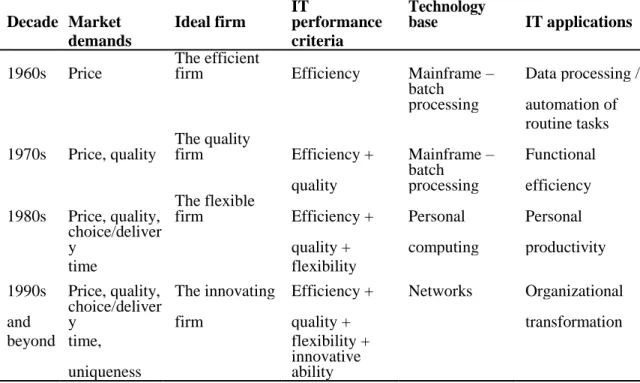
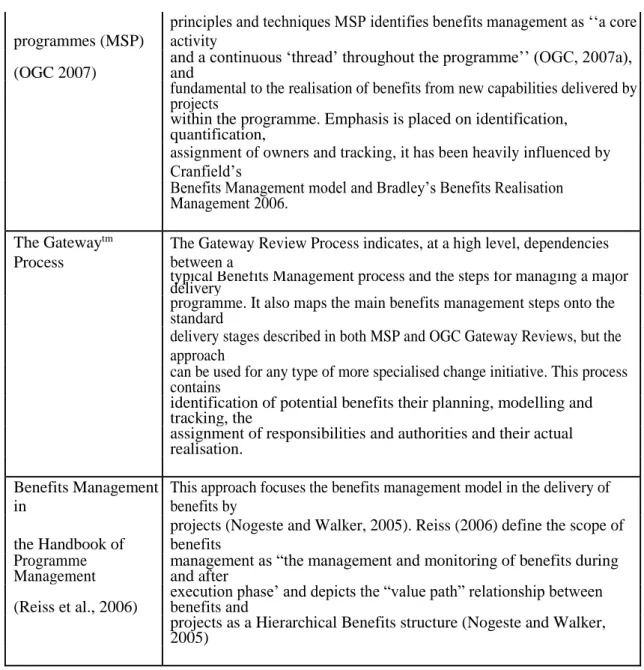
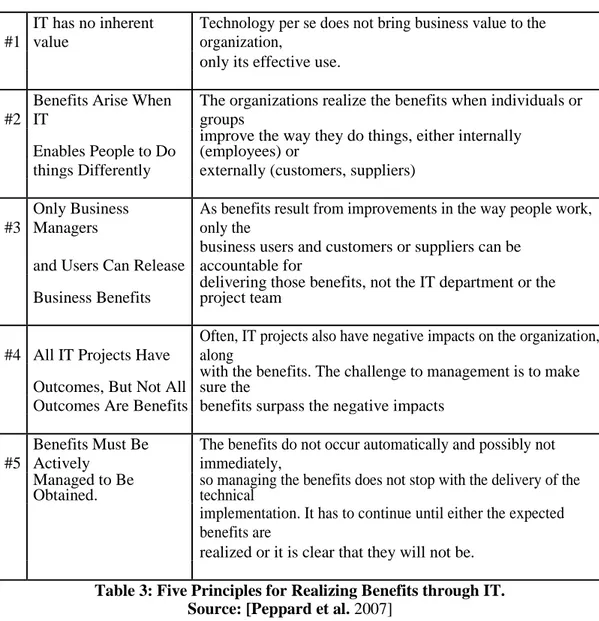
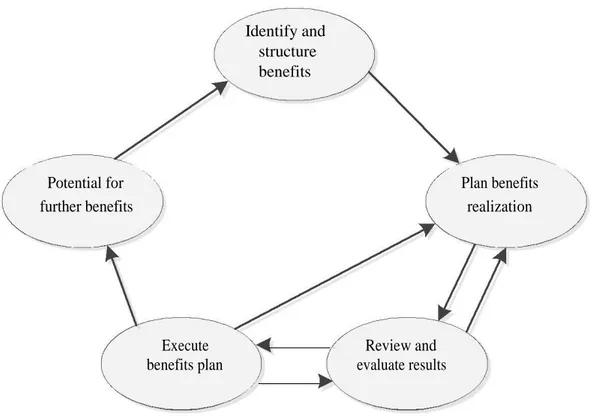
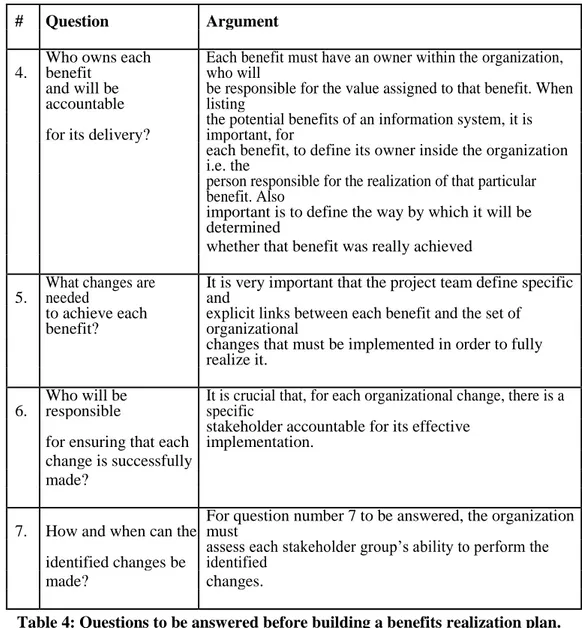
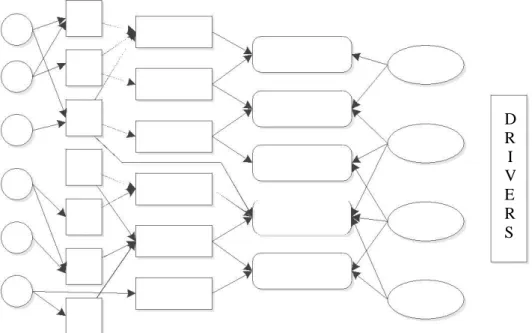
![Table 5: Reasons for failure to monitor benefits of IS/IT Source: [Lin & Pervan 2003, p.14]](https://thumb-eu.123doks.com/thumbv2/123dok_br/17030169.766589/14.892.135.770.589.1003/table-reasons-failure-monitor-benefits-source-lin-pervan.webp)